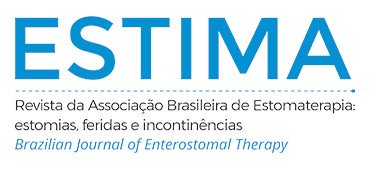MEDICAL DEVICE-RELATED PRESSURE INJURY: FREQUENCY AND ASSOCIATED FACTORS
Abstract
Objective: to analyze the occurrence of pressure injuries related to medical devices in patients admitted to an intensive care unit. Method: quantitative, observational, descriptive, prospective cohort study, carried out with 171 patients, from May 15 to August 31, 2018 in the intensive care units of a public hospital in the Federal District. Results: the main risk factors were the presence of pressure injuries at admission, with a significant association for the formation of pressure injuries related to medical devices (p=0.002), and patients who progressed to death, with an association for the formation of pressure injuries related to medical devices (p=0.012); medical device-related pressure injury incidence rate of 40.35%. Conclusion: the use of medical devices has grown, as well as the appropriation of these technologies in the critical care environment. The multidisciplinary team should be aware of the formation of pressure injuries related to medical devices that can affect hospitalized patients.
Downloads
Metrics
References
Galetto SGDS, Nascimento ERPD, Hermida PMV, Busanello J, Malfussi LBH, Lazzari DD. Medical device-related pressure injury prevention in critically ill patients: nursing care. Rev Bras Enferm. 2021;74(2): e20200062. English, Portuguese. https://doi.org/10.1590/0034-7167-2020-0062
National Pressure Ulcer Advisory Painel (NPUAP); 2016. Available at: http://www.npuap.org/resources/educational-andclinical-resources/pressure- injury-stagingillustrations/
Dalli ÖE, Girgin NK. Knowledge, perception and prevention performance of intensive care unit nurses about medical device-related pressure injuries. J Clin Nurs. 2021;1-8. https://doi.org/10.1111/jocn.16014
Dang W, Liu Y, Zhou Q, Duan Y, Gan H, Wang L et al. Risk factors of medical device-related pressure injury in intensive care units. J Clin Nurs. 2021;1-10. https://doi.org/10.1111/jocn.15974
Apold J, Rydrych D. Preventing Device-Related Pressure Ulcers. J Nurs Care Qual. 2012;27(1):28-34. https://doi.org/10.1097/NCQ.0b013e31822b1fd9
VanGilder C, Lachenbruch C, Algrim-Boyle C, Meyer S. The International Pressure Ulcer Prevalence Survey: 2006-2015: A 10-Year Pressure Injury Prevalence and Demographic Trend Analysis by Care Setting. J Wound Ostomy Continence Nurs. 2017;44(1):20-8. https://doi.org/10.1097/WON.0000000000000292
Jansen RCS, Silva KBA, Moura MES. Escala de Braden na avaliação do risco de úlcera por pressão. Rev. Bras. Enferm.2020;73(6):e20190413. http://doi.org/10.1590/0034-7167-2019-0413
Jackson D, Sarki AM, Betteridge R, Brooke J. Medical device-related pressure ulcers: A systematic review and meta-analysis. Int J Nurs Stud. 2019;92:109-20. https://doi.org/10.1016/j.ijnurstu.2019.02.006
Seong YM, Lee H, Seo JM. Development and Testing of an Algorithm to Prevent Medical Device-Related Pressure Injuries. Inquiry. 2021;2019;58:469580211050219. https://doi.org/10.1177/00469580211050219
Borghardt AT, Prado TN, Araújo TM, Rogenski NMB, Bringuente MEO. Evaluation of the pressure ulcers risk scales with critically ill patients: a prospective cohort study. Rev Latino-Am Enfermagem. 2015;23(1):28-35. https://doi.org/10.1590/0104-1169.0144.2521
Institute of neurological sciences nhs greater GLASGOW and clyde. Escala de coma de GLASGOW: Avalie da seguinte forma. 2018 [acesso em 20 out 2021]. Available at: https://www.glasgowcomascale.org/downloads/GCS-Assessment-Aid-Portuguese.pdf 12. Pereira M.G. Epidemiologia teoria e prática. Rio de Janeiro: Guanabara Koogan; 2018.
Asti E, Sironi A, Milito P, Bonavina G, Bonnita G, Bonavina L. Prevalence and risk factors of nasal pressure ulcers related to nasogastric intubation: an observational study. Eur Surg. 2017;49(4):171-4. https://doi.org/10.1007/s10353-017-0476-y
Padula CA, Paradis H, Goodwin R, Lynch J, Hegerich-Bartula D. Prevention of Medical Device–Related Pressure Injuries Associated With Respiratory Equipment Use in a Critical Care Unit. J Wound Ostomy Continence Nurs. 2017;44(2):138-41. https://doi.org/10.1097/WON.0000000000000311
Hanonu S, Karadag A. A Prospective, Descriptive Study to Determine the Rate and Characteristics of and Risk Factors for the Development of Medical Device-related Pressure Ulcers in Intensive Care Units. Ostomy Wound Management. 2016;62(2):12-22. Available at: https://www.owm.com/article/prospective-descriptive-study-determine-rate-and-characteristics-and-risk-factors
El-Marsi J, Zein-El-Dine S, Zein B, Doumit R, Badr LK. Predictors of Pressure Injuries in a Critical Care Unit in Lebanon: Prevalence, Characteristics, and Associated Factors. J Wound Ostomy Continence Nurs. 2018;45(2):131-6. https://doi.org/10.1097/WON.0000000000000415
Alderden J, Cummins MR, Pepper GA, Whitney JD, Zhang Y, Butcher R et al. Midrange Braden Subscale Scores Are Associated With Increased Risk for Pressure Injury Development Among Critical Care Patients. J Wound Ostomy Continence Nurs. 2017;44(5):420-8. https://doi.org/10.1097/WON.0000000000000349
Coyer FM, Stotts NA, Blackman VS. A prospective window into medical device-related pressure ulcers in intensive care. Int Wound J. 2014;11(6):656-64. https://doi.org/10.1111 / iwj.12026
Ham WH, Schoonhoven L, Schuurmans MJ, Leenen LP. Pressure ulcers in trauma patients with suspected spine injury: a prospective cohort study with emphasis on device-related pressure ulcers. Int Wound J. 2017;14(1):104-11. https://doi.org/10.1111/iwj.12568
Portaria n. 55 de 16 de Janeiro de 2018 (BR). Estabelece as normas e as diretrizes referentes à organização da Atenção Domiciliar da Secretaria de Estado de Saúde do Distrito Federal. Diário Oficial da União [periódico na internet], Brasília (DF). [cited 12 nov 2021]. Available at: http://www.sinj.df.gov.br/sinj/Norma/30234d464665423c8a558793d2761d46/ses_prt_55_2018.html#art5
Cox J, Roche S. Vasopressors and Development of Pressure Ulcers in Adult Critical Care Patients. Am J Crit Care. 2015;24(6):501-10. https://doi.org/10.4037/ajcc2015123
Otero DP, Domínguez DV, Fernández LH, Magariño AS, González VJ, Klepzing JVG et al. Preventing facial pressure ulcers in patients under non-invasive mechanical ventilation: a randomised control trial. J Wound Care. 2017;26(3):128-36. https://doi.org/10.12968/jowc.2017.26.3.128
Barakat-johnson M, Barnett C, Wand T, White K. Medical device-related pressure injuries: An exploratory descriptive study in an acute tertiary hospital in Australia. J Tissue Viability. 2017;26(4):246-53. https://doi.org/10.1016/j.jtv.2017.09.008
Arnold-long M, Ayer M, Borchert K. Medical Device–Related Pressure Injuries in Long-term Acute Care Hospital Setting. J Woun Ostomy Continence Nurs. 2017;44(4):325-30. https://doi.org/10.1097/WON0000000000000347
Alves P, Eberhardt T, Soares R, Pinto M, Pinto C, Vales L et al. Differential Diagnosis in Pressure Ulcers and Medical Devices. Česk Slov Neurol N. 2017;80/113(Suppl 1):29-35. https://doi.org/10.14735/amcsnn2017S29
Cavalcanti EO, Kamada I. Medical-device-related pressure injury on adults: an integrative review. Texto Contexto-Enferm. 2020;29:e20180371. https://doi.org/10.1590/1980-265x-tce-2018-0371
Downloads
Published
Versions
- 2022-04-18 (2)
- 2022-03-16 (1)
How to Cite
Issue
Section
License
Copyright (c) 2022 Euni de Oliveira Cavalcante, Ivone Kamada

This work is licensed under a Creative Commons Attribution 4.0 International License.

























